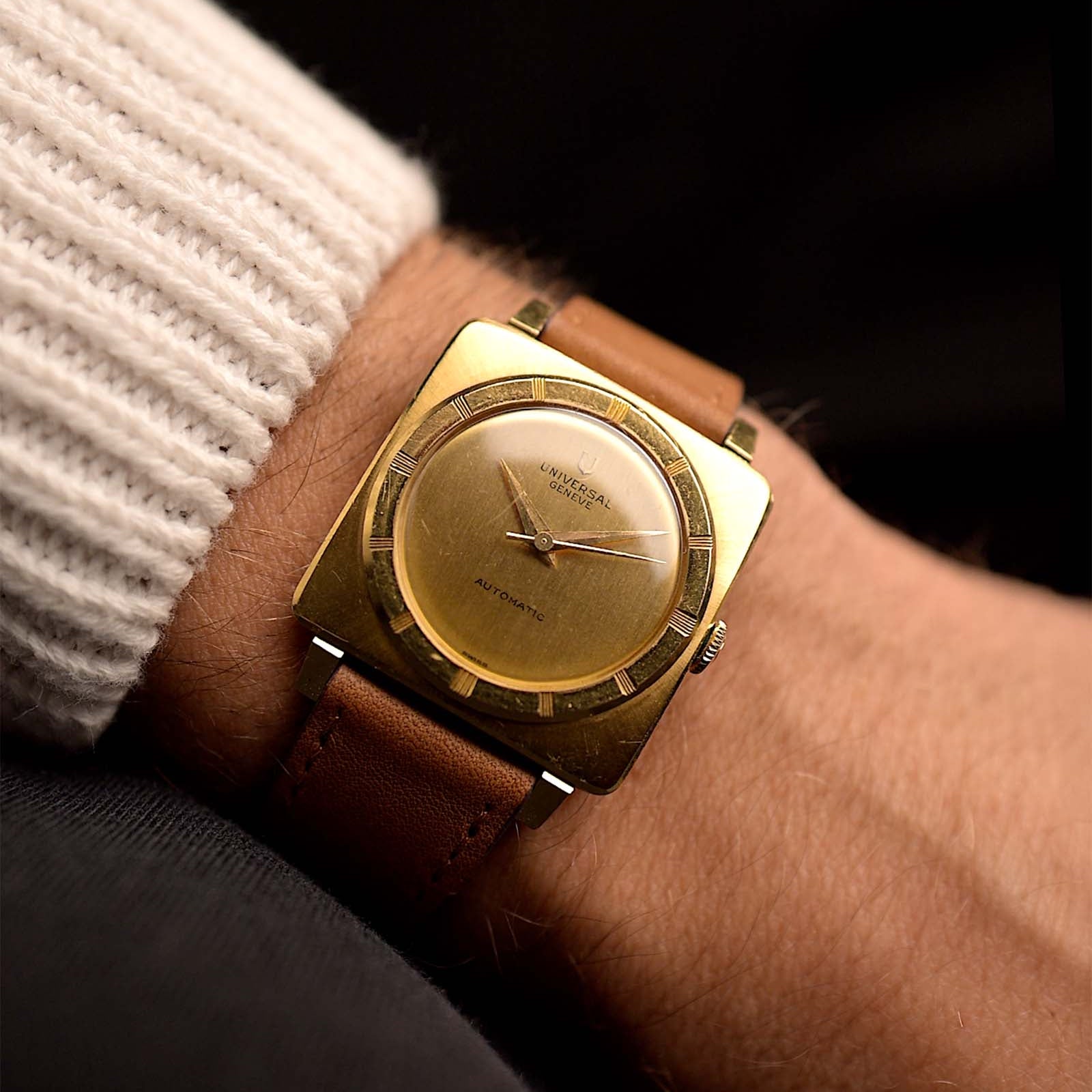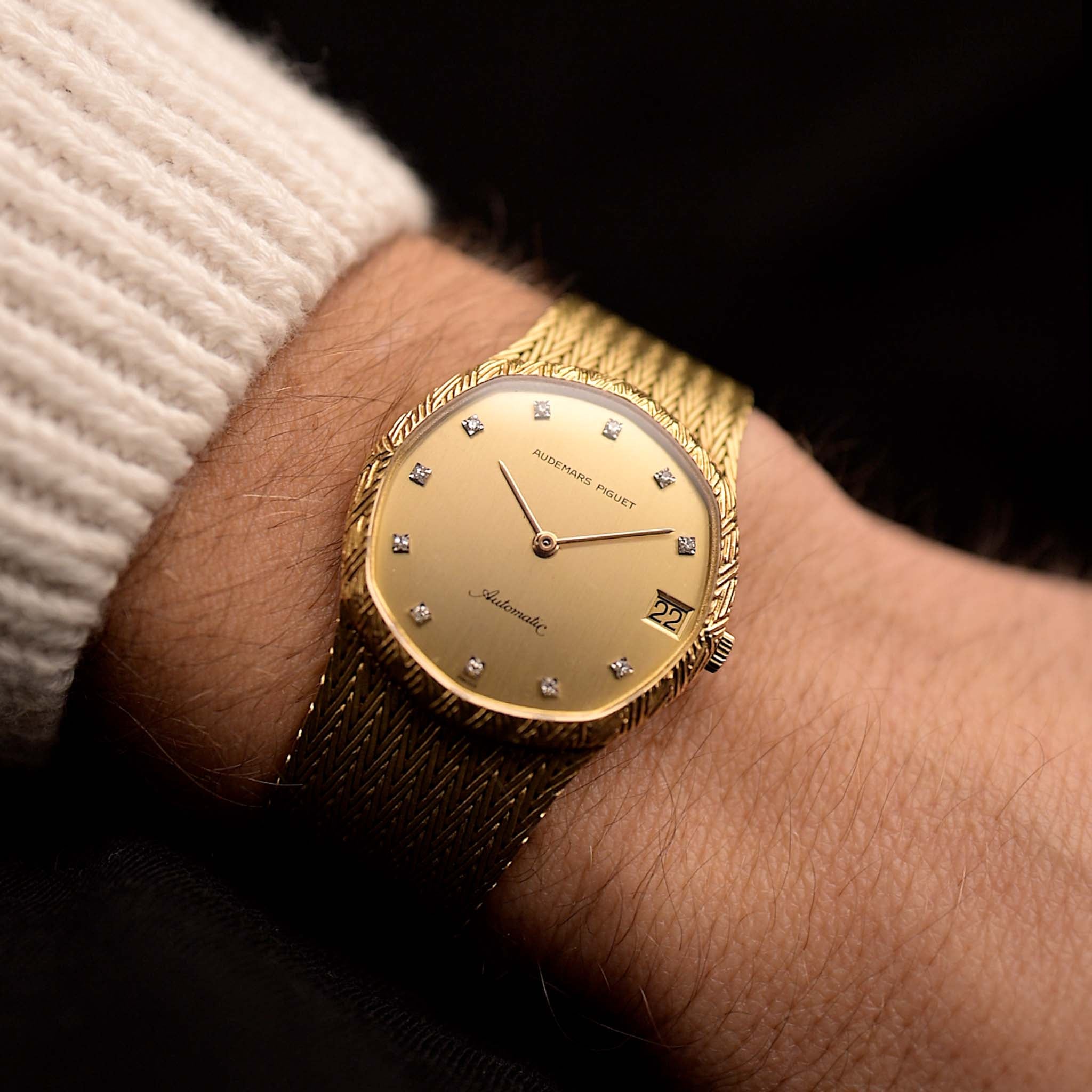Did you ever wonder who actually is the expert that knows how to best case a watch movement? The often overlooked virtue of the watch case maker. What sounds like a character from Lewis Carroll's "Alice in Wonderland" is actually an artisanal craftsman who's role has changed quite drastically over the last decades. In the early 20th century the procedure producing an entire watch was still quite decentralized. Most of the Swiss brands were developing and constructing the movements but cases and dials were mainly designed and produced by subcontractors.
November 16, 2021
The Modern History of Watch Case Making
 Marcus Siems @siemswatches
Marcus Siems @siemswatches
Collector, Author, Data Analyst
Did you ever wonder who actually is the expert that knows how to best case a watch movement? The often overlooked virtue of the watch case maker. What sounds like a character from Lewis Carroll's "Alice in Wonderland" is actually an artisanal craftsman who's role has changed quite drastically over the last decades. In the early 20th century the procedure producing an entire watch was still quite decentralized. Most of the Swiss brands were developing and constructing the movements but cases and dials were mainly designed and produced by subcontractors.
The entire system was turned upside down in 1968 with the introduction of Patek Philippe's Golden Ellipse. For the first time a watch company completely designed the case and instructed their supplier (Ateliers Réunis) on how to execute it[1,2]. A revolutionary tale. The interesting question now is if and when that paradigm shift reached the public and the mass market? Did this novelty in the watchmaking production chain spark any new trends?
 Patek Philippe Golden Ellipse... Could the development of one watch-case change the design language of an era? Photo @goldammer.me
Patek Philippe Golden Ellipse... Could the development of one watch-case change the design language of an era? Photo @goldammer.me
In this guide I will present you to the most common types of watch cases, their popularity in the different ages, for different watch types and the applied materials. And the perfect tool to do so is quantitative data analysis. I assessed over 4000 watches publicly listed on chrono24[3] to add some evidence to our own intuitions.
Round Case
Shape: It is THE shape linked to watch cases, the classic circular timepiece, an evergreen that is seldom questioned.
 Round: Just like this beautifully circular Omega Sub-Second Dress Watch. Photo @goldammer.me
Round: Just like this beautifully circular Omega Sub-Second Dress Watch. Photo @goldammer.me
Distribution: Over 90% of all the timepieces included in this analysis have a round case. In the mid 20th century up until 1965 this is almost exclusively the case. It is only from the late 1960s to the early 1980s that case designs gets a little funky and we see a dip in the round popularity all the way down to 60% in the early 1970s. The round case gets more popular again but never returns to the levels of the 1940s (max. annual market share of 99%). With such an intense monopole on a particular design feature it is only natural that all watch types have been utilizing round cases extensively themselves. But it appears that dress watches display a little more variation than the other types.
Material: As this shape is so common all throughout the last century the used materials mainly reflect the overall distribution used for watches. About a third of these pieces are made of precious metals (Gold 35%), a little more than half of them of non-precious metals (Steel 55%), and about one tenth are bicolored or gold-plated cases (Gold/Steel 10%). For comparison, when looking at all watches we see 36% gold, 54% steel and 10% gold-plated watches.
Popular examples: Rolex Submariner, Omega Seamaster, Breitling Superocean, Tudor Black Bay, Cartier Ballon Bleu
 Round case: The default watch case, almost never questioned except for the 1970s. Photo: Two-Hand Patek Philippe Dress Watch @goldammer.me
Round case: The default watch case, almost never questioned except for the 1970s. Photo: Two-Hand Patek Philippe Dress Watch @goldammer.me
Cushion Case
Shape: Similar to the round case design, the cushion does not have sharp edges on the outline. Its shape ranges from an almost rounded square (true cushion) all the way to an elongated almost elliptic shape with integrated lugs (C-shape).
 Cushion: See for example this curvy Logines Tigereye. Photo @goldammer.me
Cushion: See for example this curvy Logines Tigereye. Photo @goldammer.me
Distribution: The 1970s, the adventurous era for case designs. We see a total of four different styles that peak in the space age and the cushion case is the spearhead of this movement. With almost 25% market share in the early 70s it is the alternative to the round case and a defining factor of the time. We see many tool-watches equipped with a cushion case but especially the chronographs of the time have favored this style.
Material: As this shape is mainly associated with tool-watches it is most often produced in steel (71%), and less often in full gold (19%) or gold-plated (10%).
Popular examples: Patek Philippe Nautilus, Heuer Camaro, Omega Speedmaster Mark II, Zenith Defy Classic, Citizen Bullhead
 Cushion Case: Most prominent alternative to the round case style and a child of the special 1970s creativity in watchmaking. Photo: IWC Ingenieur SL Automatic @goldammer.me
Cushion Case: Most prominent alternative to the round case style and a child of the special 1970s creativity in watchmaking. Photo: IWC Ingenieur SL Automatic @goldammer.me
Square Case
Shape: The second most simplistic shape when it comes to watches, the square. Sometimes also called the TV-case it can feature both integrated as well as applied lugs. For our definition slight deviations from equal edge lengths are acceptable (see rectangular for a distinction below).
 Square: The manufacturer might disagree but this is one amazingly square black spider-dial must de Cartier Tank. Photo @goldammer.me
Square: The manufacturer might disagree but this is one amazingly square black spider-dial must de Cartier Tank. Photo @goldammer.me
Distribution: The square is a case shape that has always been around, it has always been rare but its distribution clearly predates the time frame of this analysis. There are two clear peaks, one in the 1950s and one in the early 1970s (max. annual market share 5%). This style has always been associated with very classic and elegant design, and was most frequently used in dress watches but in a genre-clashing fashion has been used for the iconic Heuer Monaco chronograph as well.
Material: Not surprisingly for a dress watch favorite, the squared case commonly comes in golden colors (gold 60%, gold-plated 9%).
Popular examples: Heuer Monaco, Omega Constellation 168.047, Cartier Tank, Patek Philippe 2493
 Square Case: Although it’s never been extremely popular, the square is a dress watch classic of the last century. Photo: Roman Numeral Omega Sub-Second @goldammer.me
Square Case: Although it’s never been extremely popular, the square is a dress watch classic of the last century. Photo: Roman Numeral Omega Sub-Second @goldammer.me
Oval Case
Shape: The oval case is an ellipsoid that has one evidently longer dimension (in contrast to round cases) and features no or a very short edge on the short side (contrasting it to tonneau shape). Very often an oval watch comes with integrated lugs.
 Oval: Just like this daring Omega Chronostop Geneve. Photo @goldammer.me
Oval: Just like this daring Omega Chronostop Geneve. Photo @goldammer.me
Distribution: A design that almost never occurs before 1960 but rises to a notable market share in the mid 1970s (max. annual market share 5%). It is clearly an aesthetically oriented shape and hence can be mainly found in dressier pieces.
Material: As this is again especially a dress watch style it very often comes in gold (58%) but not gold-plated (3%), which speaks for its implementation particularly in haute horologie.
Popular examples: Patek Philippe Ellipse, Chopard Ovale, Omega Geneve Dynamic
 Oval Case: The second clear 1970s case design style, but this one was most prominently used for dress watches. Photo: Patek Philippe Golden Ellipse @goldammer.me
Oval Case: The second clear 1970s case design style, but this one was most prominently used for dress watches. Photo: Patek Philippe Golden Ellipse @goldammer.me
Tonneau & Rectangular Case
Shape: In this category we got two shapes, which names are regularly used interchangeably. The two are very similar in appearance yet not identical. I still pool these two together as they also share many features in their distributions. Both have in common that the cases are longer than they are wide, more so than the classic tank. The rectangular case, as the name suggests, has four straight edges. Tonneau on the other hand is French for “barrel”. Thus, the longer edges are slightly curved and it may come with integrated lugs.
 Tonneau & Rectangular: A perfect example being this Jaeger-LeCoultre Roman Numerals Dress Watch. Photo @goldammer.me
Tonneau & Rectangular: A perfect example being this Jaeger-LeCoultre Roman Numerals Dress Watch. Photo @goldammer.me
Distribution: The tonneau and rectangular cases share a trajectory very similar to the squared case. Both have been used for dress watches, been around since before 1960 but have never been as popular as in the mid 1970s (max. annual market share 7%). However, this design has clearly been very popular early in the 20thcentury and enjoys another wave of appreciation from the 1990s onward.
Material: As a dress-watch style we do see this case over proportionally made from gold (64%) or gold-plated material (8%).
Popular examples: Patek Philippe Gondolo, Rolex Prince Elegant, Gruen Curvex, Cartier Tank Cintree, Longines Evidenza
 Tonneau & Rectangular Case: An early 20th century dress watch design that as well has been brought to new life in the 70s. Photo: Artdeco Vacheron Constantin Dress Watch @goldammer.me
Tonneau & Rectangular Case: An early 20th century dress watch design that as well has been brought to new life in the 70s. Photo: Artdeco Vacheron Constantin Dress Watch @goldammer.me
Octagonal Case
Shape: Think of a true modern day watch design icon… and there you have it the Audemars Piguet Royal Oak with its octagonal shape. An edgy industrial design with integrated lugs (integrated bracelet even) that sticks out of the pack. However, the octagonal shape might most likely has found its way into the affordable horological world through the manufacture of Cartier in 1978 (Cartier Santos Octagon).
Distribution: A daring design nowadays most prominently associated with Gerald Genta and Audemars Piguets Royal Oak[4]. A truly revolutionary one as such a case shape has virtually been absent from the market before the watch hit the market in 1972. As a high-end watchmaking device the Royal Oak itself will never sell enough to really skew the overall market. However, combine it with Cartier and the sparked interest of several other watch manufacturers, the octagonal shape still gets to a peak annual market share of just a little under 4% in the 1980s and 90s.
Material: Interestingly, the octagonal watches draw from a very special set of materials. Thinking back to the Royal Oak and the Santos Octagon, watches that have been invented as a new kind of sturdy yet classy steel watch. However, the percentage of steel octagonal watches is quite low with 47%. On the other hand, as high as with no other case style bicolored material is quite prominent (17%), which is likely due to the common (and slightly more affordable) bicolored Royal Oak and Cartier variations around the time of its peak (the 1980s and 90s).
Popular examples: Audemars Piguet Royal Oak, Bulgari Octo Finissimo, Cartier Santos Octagon
 Octagonal Case: Most famous through Gerald Genta's design – the Royal Oak. A blueprint that has found its way into several other lineups but most likely was introduced with the Cartier Santos Octagon. Photo: Initial drawing/concept of the Audemars Piguet Royal Oak 5402.
Octagonal Case: Most famous through Gerald Genta's design – the Royal Oak. A blueprint that has found its way into several other lineups but most likely was introduced with the Cartier Santos Octagon. Photo: Initial drawing/concept of the Audemars Piguet Royal Oak 5402.
If the 1980s have been the time of colorful bezel styles it were the 1970s that experimented most with the overall case design. A simple re-ordering of the watchmaking supply chain was enough to establish a cornucopia of different shapes.
 Case Shape Overview: Cases seem to have always been kinda round, except for the wild 70s.
Case Shape Overview: Cases seem to have always been kinda round, except for the wild 70s.
Not only did the watch industry invent more or less unseen case designs in the 1970s they also reinterpreted classic styles. The square case is the best example. It has been incorporated in very elegant subtle dress watches particularly in the 1950s, seen for example on several models from renowned Swiss watchmakers like Audemars Piguet, Patek Philippe and Vacheron Constantin. But in the 1970s this design has been used for one of the most iconic and groundbreaking sports watches of all time – the Heuer Monaco (technically starting in 1969). From then on similar “TV-cases” were found in the sportier collections of almost all manufacturers. That’s a complete turnaround on the idea originally associated with the shape.
Questioning what is good and what is necessary for function is an inherent part of watch design or better design in general. It’s not only about what is hip but also what the people need. For the perfect wrist experience form and function have to come together. And in the 70s this meant to completely break with all conventions of how to case a watch movement.
 The 1970s definitely brought us some fresh new cases. Photo @goldammer.me
The 1970s definitely brought us some fresh new cases. Photo @goldammer.me
The case was a "new" design element to use for your own imagination. But as with any trend this didn’t last forever; beginning in the mid 1980s the round watchcase was back at 90% market share. However, it never fully returned to the 1950s levels, which leaves us with one main conclusion: In the watch enthusiasts’ hearts a non-circular hole has remained ever since.
Side Note: This guide is missing a few classic shapes - this includes the asymmetrical (for example Rolex Midas) and other more avant-garde case designs. In the end I had to leave those out as there was just too little data (at the moment) to draw a conclusive picture about the distribution of those styles. I might be able to add them at a later time point. Also, to prevent a similar loss of data that is the reason I combined the information of the rectangular and the tonneau case shapes. You can check the references for further info on the topic as well.
Check out the guides here:
The Ultimate Watch Hand Guide Part I & Part II
The Modern History of Watch Case Making Part I
References
[1] The History Of The Golden Ellipse; Tania Edwards, Collectability;
https://collectability.com/learn/the-history-of-the-golden-ellipse/
[2] Patek Philippe Golden Ellipse – the first 18k blue gold dial; Felix Goldammer, Goldammer Vintage Watches;
https://www.youtube.com/watch?v=0gXHHeAI5rQ
[3] Watches from Chrono24, extracted 2020 Nov. 29th; Karlsruhe, Germany;
[4] History of the Audemars Piguet Royal Oak; Alessandro Mazzardo, Time And Watches;
https://www.timeandwatches.com/p/history-of-audemars-piguet-royal-oak.html
[5] The Most Unusual Patek Philippe Case Designs Of The Past 100 Years; A Collected Man;
https://www.acollectedman.com/blogs/journal/most-unusual-patek-philippe-case-designs-past-100-years
[6] A Guide to Watch Case Shapes and Designs; Andrew Connor, Gear Patrol;
https://www.gearpatrol.com/watches/a486351/watch-case-shapes-guide/
All rights on text and graphics reserved to the Author.




























2 comments
The “adventurous era” of the 1970s could be attributed to the surge of the digital display. Manufacturers new to the business (like TI) took a different approach to watch case design, one less based on tradition.
I’ve read through this and several of your other articles. Excellent read and very insightful. Thanks for doing all this research!
Leave a comment